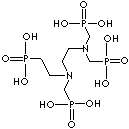| CAS
NO. |
1429-50-1 |

|
| EINECS
NO. |
215-851-5 |
| FORMULA |
C6H20N2O12P4 |
| MOL
WT. |
436.13 |
|
H.S.
CODE
|
|
|
TOXICITY
|
|
|
SYNONYMS |
Ethylenebis(nitrilodimethylene)tetraphosphonic acid;
|
| [1,2-Ethanediylbis[nitrilobis-(methylene)]]
tetrakis-phosphonic
acid;
N,N,N',N'-Ethylenediamine tetra(methylenephosphonic acid); Ethylenediamine-n,n,n',n'-tetrakis-(methylenephosphonic acid);
EDTMP; |
| SMILES |
|
| CLASSIFICATION
|
|
|
PHYSICAL
AND CHEMICAL PROPERTIES
|
| PHYSICAL
STATE |
white
solid
|
|
MELTING
POINT
|
|
| BOILING
POINT |
|
| SPECIFIC
GRAVITY |
|
|
SOLUBILITY
IN WATER
|
miscible
|
| pH |
<
2 (1.0% sol.)
|
| VAPOR
DENSITY |
|
|
AUTOIGNITION
|
|
|
NFPA
RATINGS
|
|
|
REFRACTIVE
INDEX
|
|
| FLASH
POINT |
|
| STABILITY |
Stable
under ordinary conditions |
|
APPLICATIONS
|
|
Phosphonates derived from phosphorous (phosphonic) acid are employed in the
applications of scale Inhibition, sequestration, dispersion and corrosion
inhibition in addition to the main applications of agricultural chemicals such
as fertilizers, pesticides, and soil conditioners. Phosphonates offer a wide
range of sequestrants to control metal ions in aqueous systems. By forming
stable water soluble complexes with multivalent metal ions, phosphonates prevent
undesired interaction by blocking normal reactivity of metal ions. This ability
contributes to function as threshold industrial water treatment and metal
treatment processes (antiscalants, corrosion inhibitors, chelants, sludge
conditioners, pulp bleachings, deflocculants, dispersants, metal cleaners,
electroplating and crystal growth modifiers). Phosphonates are also used in
manufacturing detergents, cosmetics and personal care products for special
functions such as low levels iron control, stain removal, bleach stabilization,
peroxide stabilization and anti-encrustation. Phosphonates existing in various
compounds as acids or salts are marketed in the form of concentrated solutions.
|
| SALES
SPECIFICATION |
|
APPEARANCE
|
white
solid
|
| ASSAY |
90.0%
min
|
|
WATER
|
10.0%
max
|
|
CHLORIDES
|
0.5%
max
|
| TRANSPORTATION |
| PACKING |
50kgs
in fiber drum |
| HAZARD
CLASS |
8
(Packing Group: III ) |
| UN
NO. |
1760 |
| OTHER
INFORMATION |
|
European
Hazard Symbols: C,
Risk Phrases: 10/35, Safety Phrases: 9/16/23/26/28A/33/36 |
|
GENERAL
DESCRIPTION OF CHELATING AGENT |
|
Chelation is a
chemical combination with a metal in complexes in which the metal is part of a
ring. Organic ligand is called chelator or chelating agent, the chelate is a
metal complex. The larger number of ring closures to a metal atom is the more
stable the compound. This phenomenon is called the chelate effect; it is
generally attributed to an increase in the thermodynamic quantity called entropy
that accompanies chelation. The stability of a chelate is also related to the
number of atoms in the chelate ring. Monodentate ligands which have one
coordinating atom like H2O or
NH3 are easily broken
apart by other chemical processes, whereas polydentate chelators, donating
multiple binds to metal ion, provide more stable complexes. Chlorophyll, green
plant pigment, is a chelate that consists of a central magnesium atom joined
with four complex chelating agent (pyrrole ring). The molecular structure of the
chlorophyll is similar to that of the heme bound to proteins to form hemoglobin,
except that the latter contains iron(II) ion in the center of the porphyrin.
Heme is an iron chelate. Chelation is applied in metal complex chemistry,
organic and inorganic chemistry, biochemistry, and environment protection. It is
used in chemotherapeutic treatments for metal poisoning. Chelating agents offers
a wide range of sequestrants to control metal ions in aqueous systems. By
forming stable water soluble complexes with multivalent metal ions, chelating
agents prevent undesired interaction by blocking normal reactivity of metal
ions. EDTA, ethylenediaminetetraacetate (hexadentating), is a good example of
common chelating agent which have nitrogen atoms and short chain carboxylic
groups. The sodium salt of EDTA is used as an antidote for metal poisoning, an
anticoagulant, and an ingredient in a variety of detergents. Chelating agents
are important in the field of soap, detergents, textile dyeing, water softening,
metal finishing and plating, pulp and paper, enzyme deactivation, photo
chemistry, and bacteriocides. |
